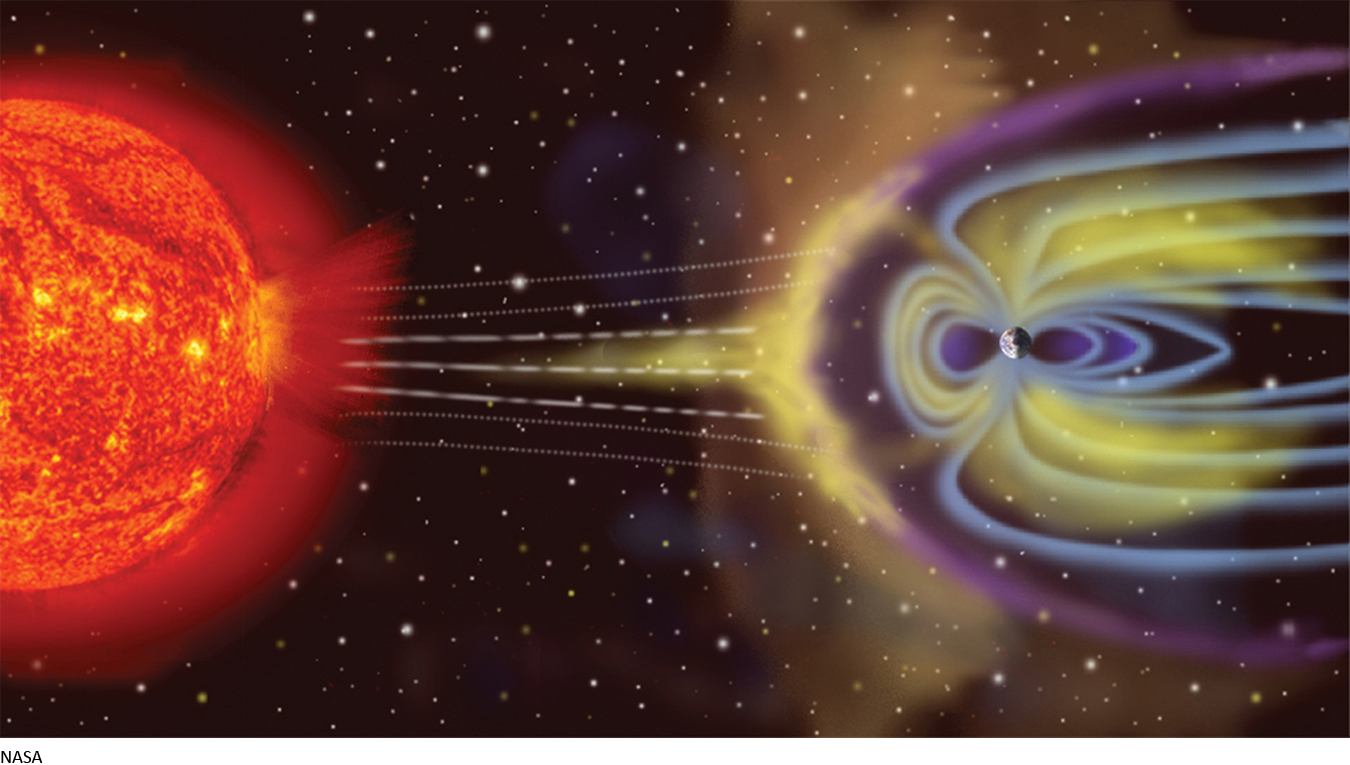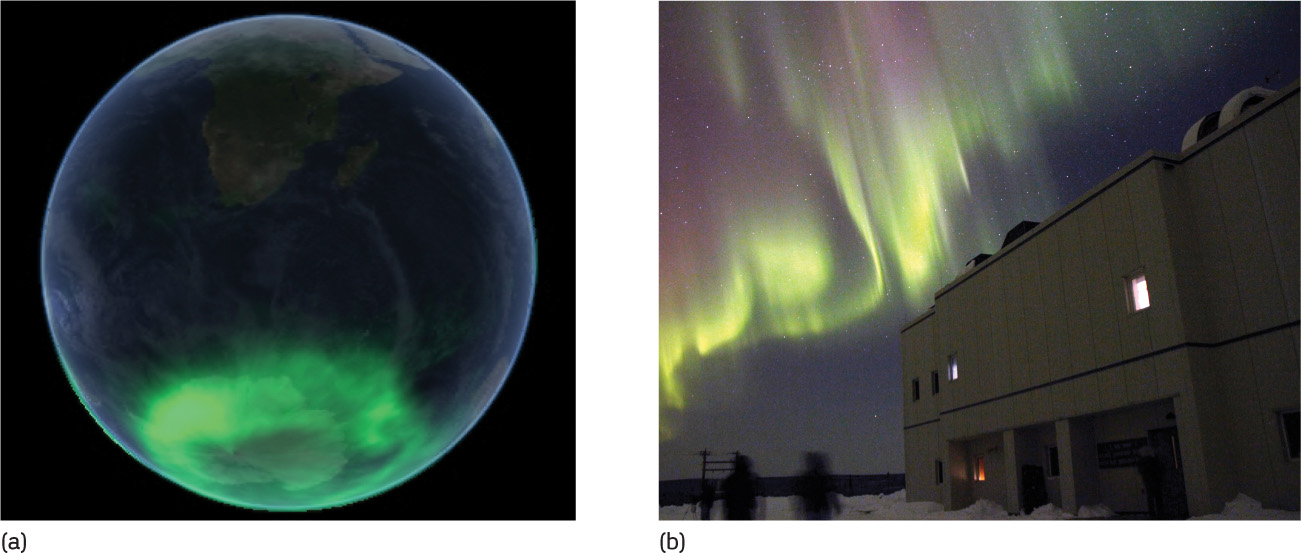5-4 Earth’s magnetic field emanating from its spinning, molten interior creates a protective shield from the Sun’s harmful radiation
The extent of a planet’s dynamic resurfacing due to plate tectonics provides indirect evidence about whether it still has a molten interior. But another, more direct tool for probing the interior of Earth is an ordinary compass, which senses the magnetic field outside our planet. Magnetic field measurements prove to be an extremely powerful way to investigate the internal structure of a world without having to actually dig into its interior. To illustrate how this works, consider the behavior of a compass on Earth.
Source of Earth’s Magnetic Field
The needle of a compass on Earth points north because it aligns with Earth’s magnetic field. Such fields arise whenever electrically charged particles are in motion. For example, a loop of wire carrying an electric current generates a magnetic field in the space around it. The magnetic field that surrounds an ordinary bar magnet is created by the motions of negatively charged electrons within the iron atoms of which the magnet is made. Earth’s magnetic field is similar to that of a bar magnet, as Figure 5-19 shows. The consensus among geologists is that this magnetic field is caused by the motion of the liquid portions of Earth’s interior. Because this molten material—mostly iron—conducts electricity, these motions give rise to electric currents, which in turn produce Earth’s magnetic field. Our planet’s rotation helps to sustain these motions and hence the magnetic field. This process for producing a magnetic field is called a dynamo.

Studies of ancient rocks reinforce the idea that our planet’s magnetism is due to fluid material in motion. When iron-bearing lava cools and solidifies to form igneous rock, it becomes magnetized in the direction of Earth’s magnetic field. By analyzing samples of igneous rock of different ages from around the world, geologists have found that Earth’s magnetic field actually flips over and reverses direction on an irregular schedule ranging from tens of thousands to hundreds of thousands of years. As an example, lava that solidified 30,000 years ago is magnetized in the opposite direction to lava that has solidified recently. Therefore, 30,000 years ago a compass needle would have pointed south, not north! If Earth were a permanent magnet, like the small magnets used to attach notes to refrigerators, it would be hard to imagine how its magnetic field could spontaneously reverse direction. But computer simulations show that fields produced by moving fluids in Earth’s outer core do indeed change direction from time to time.
Question
ConceptCheck 5-13: If Earth’s iron-rich core solidified, would a magnetic compass still point north?
The Magnetosphere
Is the magnetic field useful for anything other than helping Earth’s inhabitants determine direction using a compass? As it turns out, Earth’s magnetic field has important effects far above Earth’s surface, where it interacts dramatically with charged particles from the Sun, a flow of mostly protons and electrons, known as the solar wind, which streams constantly outward from the Sun’s upper atmosphere. Near Earth, the particles in the solar wind move at speeds of roughly a million miles per hour or about 450 km/s, considerably faster than sound waves can travel in the very thin gas between the planets, so the solar wind is said to be supersonic. (Because the gas between the planets is so thin, interplanetary sound waves carry too little energy to be heard by astronauts.)
If Earth had no magnetic field, it would be continually bombarded by this solar wind of charged particles. But our planet does have a magnetic field, and the forces that this field can exert on charged particles are strong enough to deflect them away from us. The region of space around a planet in which the motion of charged particles is dominated by the planet’s magnetic field is called the planet’s magnetosphere. Figure 5-20 is an illustration of Earth’s magnetosphere, which was discovered in the late 1950s by the first satellites placed in orbit.
When the supersonic particles in the solar wind first encounter Earth’s magnetic field, they abruptly slow to subsonic speeds. Most of the particles of the solar wind are deflected around the magnetosphere, just as water is deflected to either side of the bow of a ship. And, just like ships tend to leak, some charged particles of the solar wind manage to leak into the magnetosphere and make their way to Earth’s surface.

131
Question
ConceptCheck 5-14: Does Earth’s magnetosphere capture or deflect away particles in the Sun’s solar wind?
Aurorae
 Go to Video 5-3
Go to Video 5-3
When some particles leak through the magnetic fields at weak points, they gather and cascade down into Earth’s upper atmosphere near the poles, usually making an oval-shaped pattern (Figure 5-21a). As these high-speed charged particles collide with atoms in the upper atmosphere, they excite the atoms to high energy levels. The atoms then emit visible light as they drop down to their ground states, like the excited gas atoms in a neon light. The result is a beautiful, shimmering display called an aurora (plural aurorae). These are also called the northern lights (aurora borealis) or southern lights (aurora australis), depending on the hemisphere in which the phenomenon is observed. Figure 5-21b shows the aurora as seen from Earth’s surface. Occasionally, a violent event on the Sun’s surface sends a particularly intense burst of protons and electrons toward Earth. The resulting auroral display can be exceptionally bright and can often be seen over a wide range of latitudes. Such events also disturb radio transmissions and can damage communications satellites and transmission lines. It is remarkable that Earth’s magnetosphere and the complex space weather systems it shields us from were entirely unknown until a few decades ago. Such discoveries remind us of how little we truly understand and how much remains to be learned even about our own planet.
Earth’s magnetic field protects Earth from a flow of charged particles from the Sun, which cause aurora when small amounts collide with molecules in Earth’s upper atmosphere.

132
Question
ConceptCheck 5-15: When the aurora is visible, what exactly in the sky is glowing?